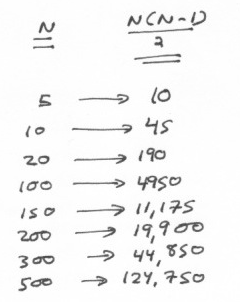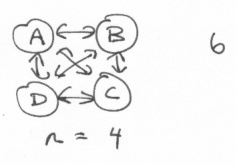Vision: a cure for meetings
“What are we doing, and who’s doing it?”
“I don’t know–let’s have a meeting about it!”
Depending on your perspective, meetings are a necessary (or unnecessary) evil. People and organizations can become good at running meetings, but before you get good at something you should ask yourself–should we even be doing this in the first place?
There are myriad reasons for meetings, and this blog post can’t solve your meeting problems–only you can, and only once you have a good understanding of your particular meeting problems. This blog post isn’t about how to run meetings more effectively, either. This post is about a common but difficult-to-notice reason for meetings: nobody knows what they’re supposed to be doing!
Here are some questions to help you identify this problem in your organization:
- Do you understand what is expected of you? If not, where do you go to clarify those expectations? Does what you’re expected to do change, and if so how do you find out?
- Do you struggle to understand who’s responsible for things?
- Are you given new work? If so, how do you find out about that work? As you’re doing that work, how do you test to see what’s valuable to the customer?
- If you work in a team, how does the team figure out who’s doing what on the team?
- How do you make sure two different people do their work in the same way?
- How do you understand work priorities?
Now, I am not saying you should eliminate meetings entirely. Meetings are an appropriate way to clarify the above items: for example, it’s very important to meet and check in with customers to understand what problems they are trying to solve and what they perceive as valuable. However, meetings are not the only way to learn what’s expected and what’s needed.
I am going to give you another option for clarifying goals and expectations, and I’ll go ahead and tell you the answer is “vision,” but before I do that let me talk about the difficulty of getting people to see eye-to-eye.
An aside: communications channels
Meetings are a method for communicating. Communications get much more difficult the more people are involved. For each person involved, there is a “communications channel” between those people.
When you only have one person, there are no communications channels.
If you only have two people, there’s only one communications channel. And we know how simple it is to have only one communications channel! 🙂
Three’s a crowd. There are three people and 3 communications channels. After this point there will be more communications channels than people.
Now we have 6 communications channels for four people.

The formula to describe the number of communications channels based on the number of people is:
n*(n-1)/2
Arguably, the complexity created by adding people is a big reason for why managers (people managers, project managers, coordinators, etc) have a job. It gets really difficult for people to self-organize when there are so many communications channels. Having one clear point person everyone communicates through minimizes the number of common communications channels (however painful it might be for that person).
In the spirit of “do we even need to solve this problem,” organizations have several options to minimize the number of intra-organization communications channels:
- minimize project team/committee/group sizes
- segregate job duties into clearly defined, separate teams
This is part of why people say Scrum groups should be 6±2 (or 7±2). A challenge with trying to create smaller groups, however, is that the “small groups” may still be expected to work with other groups, get sign-offs, or otherwise include other people–keeping the number of actual communications channels quite high.
What do I mean by “vision”?
The word “vision” means different things to different people. It’s commonly used in organizational planning, when people talk about having a vision statement and a mission. However, I’m going to use the term more broadly.
When I say “vision,” I mean a clear, over-communicated, planned, shared, and accurate understanding of where an organization should be going and how you can help. I say
- “clear” because the vision should be unambiguous, using little jargon and few assumptions about the reader’s background, so that everyone can absorb it.
- “over-communicated” because you need to overcome the communications channels as described above. Everyone in the organization needs to be aware, and communicators tend to be too optimistic about who has heard the message.
- “planned” because vision is figured out before events happen. Vision is a framework for people working together.
- “shared” because people have to have similar mental models. Things need to click for people.
- “accurate” because the vision needs to be put into action and used. It needs to be checked, adjusted, and refined. It needs to represent the actual goals better than any other source, so that it’s trusted.
Here are some common types of IT artifacts that tend to define vision:
- Vision and mission statements
- Values statements
- Strategic plans
- Operational plans/roadmaps
- Infrastructure plans
- Charters
- Service level agreements
- Architectural standards
Even if these artifacts exist, it’s important to make sure they don’t contradict one another. Ideally, all the documents that explain how IT works should be clear, should be used, and should make sense when compared together.
Vision needs to be built and shared in many overlapping ways, such as…
- meetings 🙂 including “one-way” announcement-type meetings and interactive vision-building sessions
- PowerPoint slides
- print-outs
- Google Docs
- sticky notes
- whiteboard drawings
- recordings
…where some of these are more collaborative and inclusive than others. I’ve heard of one organization that sent each manager a DVD of the CEO talking through the organization’s strategic plans. The managers were expected to watch the DVDs with their teams and add their comments about how their team in particular would implement these plans. This is an extremely effective way to ensure everyone has heard the same message, and they understand how it applies to them.
That said, I do not think that the vision should be generated by one person in an ivory tower–vision needs to be built together. However, everyone needs to understand their role(s) in defining and refining the vision. The Lean book Getting the Right Things Done has a great approach for how to involve an entire organization appropriately in vision, goal-setting, and strategic planning.
How does vision help?
For a long time I struggled with how vision would help “in the real world.” How does the effort in creating a vision and plan translate into reduced costs or increased value? One of the metrics I propose for the value of developing a vision is: does it reduce the ongoing number of person-meeting-hours for equivalent work?
Here are some specific things vision should do to reduce the number of hours people spend in meetings:
Vision can clarify who’s accountable for things. Even an organizational chart is a form of a vision, in that it clearly communicates who manages whom. Other complementary documents can clarify how teams work together, or the intentions behind the organizational chart. Clarifying accountability reduces the number of meetings and the number of people in meetings.
Vision can clarify what’s important. A good strategy says what you shouldn’t do as much as what you should. Clear priorities should result in fewer work-in-progress items, meaning more time can be spent completing the work and less time spent discussing it.
Vision can help people make similar decisions without meeting. No longer will two different people say you should be doing two different things. You no longer need so many meetings to agree on things when the vision can be clearly applied.
Vision can help ensure people are philosophically aligned in how they are working. If you’re a techie or a business analyst you can read this as “clarity of non-functional requirements.” What are the values that undergrid your work? Do you want to make sure data is secure? That people are thinking about maintainability? Vision can help people make the right calls in the moment, for example to assume row-based database access because you have a value of defense-in-depth security.
Vision can empower staff to do the right thing. If a vision is outcome-oriented (i.e. what should things look like), then people can figure out their own ways for helping achieve those outcomes. For example, if a specific outcome for an organization is to have fewer than 5% of a project’s effort be spent in meetings, then project managers can invest in other ways to keep on top of projects besides status meetings–for example, by using a project management tool that has a self-service component for project team members.
OK–so how do I do this?
Doing it is the hard part. If the organizational vision is more murky, people are rewarded in part by how close they are to the decision-makers and how well they can intuit/deduce the vision from observed decisions. In practice, there is a vision, it’s just in someone’s head rather than written down and communicated.
No matter where you are in the organization, you can “guess and check.” You can make guesses for where the organization is going and check with your manager or others. You can guess by looking at decisions and extrapolating why those decisions may have been made. (For example, if it’s decided to use a virtual machine rather than a server, you can guess there is a goal to have fewer physical servers.)
You can role-model vision-building. No matter your job, there are some things you have to make decisions about–how to greet people, how long to stay on the phone, or how you’re going to write a program. Build a vision and use it. Get better at “personal vision-building,” and show people what you’re doing.
When you do attend meetings, keep your “antennae up” for vision and draw attention to it. If someone says, “we don’t want HIPAA data in our data center,” there’s probably more to that. You could say, “could you tell me more about the concern about HIPAA?” to learn whether the organization is generally risk averse or has some explicit (to others) mandate to avoid medical information.
As a corollary, when you run meetings yourself, clarify and check your vision. Spend time in your meetings making sure people understand why you thought they should be there, and what you think should be done–so people can add their understanding and help you refine your understanding.
If you’re a leader, do all the above and make a case for vision-building. “Making the case” looks very different depending on your organization–people may be sold on reducing the number of meetings, or maybe you make decisions based on return on investment. If you are a leader, though, one of the most cost-effective ways for you and others to make sure the organization is going in the direction you want is to have a clear vision.
Here’s a dirty little secret to help with selling the need for vision: executives don’t know what the organization is doing either. They can’t (and really, they shouldn’t)! Unless you are in a tiny shop, there are too many people to know much of what everyone’s doing. But vision can help ensure everyone is rowing in the same direction, and in the right direction.



